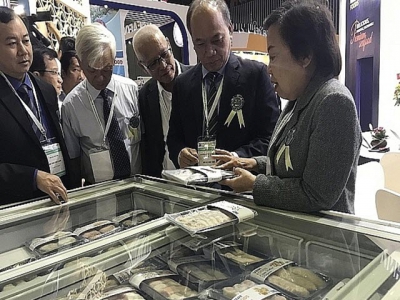CPTPP creates opportunity for pangasius exports to Japan

Japan has entered the 10 largestpangasiusexport markets of Vietnam, with benefits from CPTPP, this market becomes a potential market of Vietnam’s fishery enterprises, especially pangasius.
Truong Le Khanh, Chairwoman of the Board of Management of Vinh Hoan Corp an exporter of pangasius products. Photo: T.H
According to the Vietnam Association of Seafood Exporters and Producers, from April 2019, according to the EPA tariff rates of Japan Customs, fresh and exported fresh and chilled pangasius HS code 030432 to Japan from Thailand, Mexico, Chile, Philippines are exempted from import tax, and from ASEAN is applied 3.5% of tax rate and from CPTPP is exempted from tax.
Vietnam’s frozen fillet pangasius products exported to Japan are exempted from import tax.
With the two free trade deals signed by Japan and Vietnam and ASEAN- Japan, some fishery products of Vietnam exported to Japan have had tariff barriers abolished. With the CPTTP, many fishery products exported to Japan also enjoy 0% tax.
Among fishery products enjoying 0% tax since the CPTTP took effect, pangasius products are exempted from import tax. Thus, with benefit from three FTAs with Japan, pangasius exporters have more opportunities to increase pangasius shipmentsto the Japan market.
Japan as one of import markets in Asia has import Vietnam’s pangasius. 2018 saw export growth of pangasius to Japan. In 2018, total export value of pangasius to Japan increased by 37.6% compared to 2017. In the first three months of 2019, exported pangasius to Japan reached US$8.58 million, increasing by 60.37% compared to 2018. This value is higher than export value in other potential markets.
Currently, export value of pangasius to Japan has increased 12 times compared to 2011. This shows that Vietnam’s pangasius exporters have conquered this fastidious market and realized the potential inthis country.
Because Japanese tastes are afraid of the strong smell of freshwater fish products and incorrect prejudices about the quality correlation between freshwater fish and fish farmed or exploited from the sea, in the past, Japanese people rarely eat imported freshwater fish products. However, many Vietnamese pangasius exporters understand the consumption tastes of Japanese customers. Pangasius products processed as eel is an example.
Eel is a premium dish in Japan with prices up to more than 24 USD/eel. However, Japanese eels are facing the risk of depletion due to overfishing. Japanese businesses have imported Vietnamese pangasius and processed the same as Japanese eel with a price of a third, while the taste is equivalent. In 2017, pangasius has a good effect on Japanese consumers with this dish.
The Vietnam Association of Seafood Exporters and Producers said that there are many opportunity for Vietnamese Pangasius exporters to conquer this market. Currently, Japan has officially ranked the top 10 largest pangasius export markets of Vietnam in the first three months of 2019.
Có thể bạn quan tâm
Phần mềm

Phối trộn thức ăn chăn nuôi

Pha dung dịch thủy canh

Định mức cho tôm ăn

Phối trộn phân bón NPK

Xác định tỷ lệ tôm sống

Chuyển đổi đơn vị phân bón

Xác định công suất sục khí

Chuyển đổi đơn vị tôm

Tính diện tích nhà kính

Tính thể tích ao hồ



 US lifts anti-dumping tariffs from Vietnamese shrimp
US lifts anti-dumping tariffs from Vietnamese shrimp  Getting aquaculture right: how conservation science can help
Getting aquaculture right: how conservation science can help